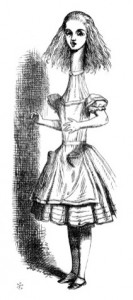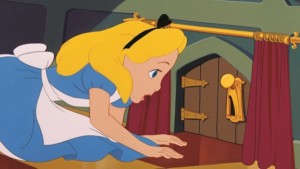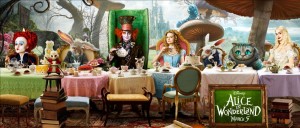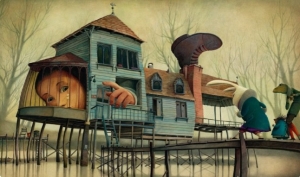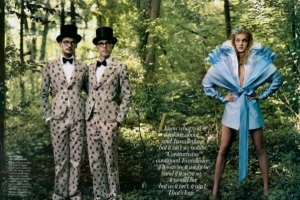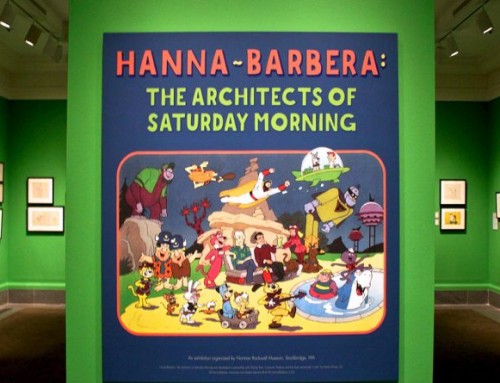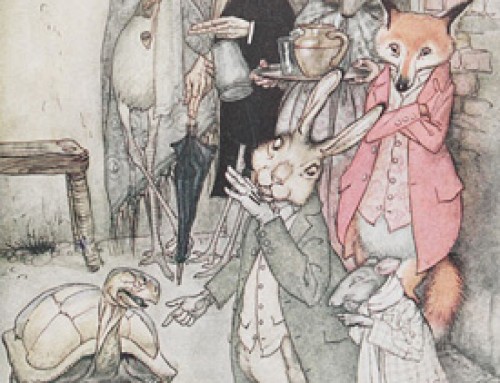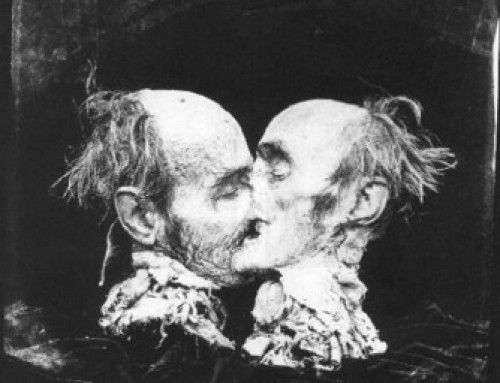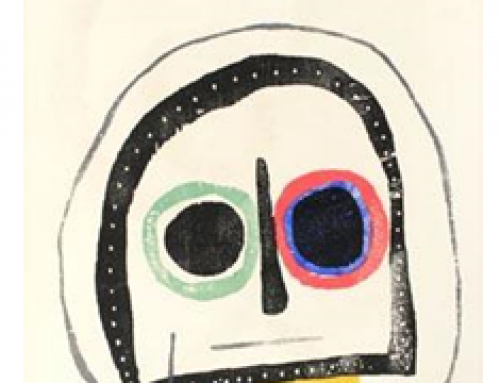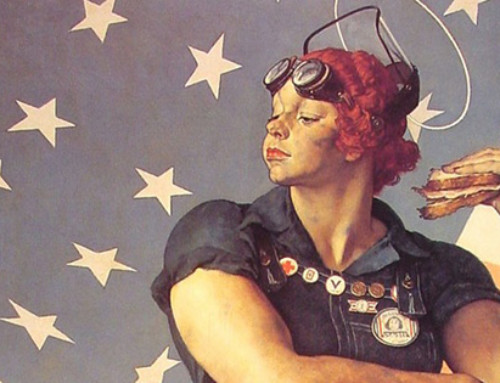By JiYeon Pak, grad student MICA’s MFA Illustration Practice, Fall 2013, Critical Seminar, Final Paper.
When you imagine a girl in a fantasy world, what is the first image that comes in your mind?
The answer is probably Alice in Wonderland. Alice in Wonderland is a novel written by Lewis Carroll (1832-1898) in 1865. This novel started from a story that Lewis told to his friend’s daughter Alice and her sisters. At that time, all stories made for children tried to teach the moralities of life. Therefore, Alice in Wonderland as considered an inventive story, because it’s about the girl’s adventure with bizarre characters in a fantasy world.
John Tenniel (1820-1914) drew the original illustrations for Alice in Wonderland. He was an illustrator, graphic humorist, and political cartoonist in the late 1800s in England. Although he was famous for a large number of political cartoons, most of his fame came from his illustrations of Alice.[3] One of the features of Tenniel’s illustrations is that Alice maintains an expressionless face in most of the scenes. Even in dangerous situations, stoic Alice moves stiffly. There must be a reason why Tenniel drew Alice in that way. Alice in Wonderland is not just an exciting story. It is a story about a girl who is searching to find her way home. I believe that Tenniel wanted to focus on the fears associated with the mysterious fantasy world more than a thrilling adventure. His engraved rough lines and monochromatic colors effectively express the gloomy feeling of this story.
Tenniel visualized this unusual bit of literature with his copious imagination. Alice in Wonderland is a story that does not focus on the importance of morality or ethics. In its own story manner, Alice in Wonderland was sensational enough compared to other stories of that period. There is no doubt that the grotesque and scary illustrations of Alice were initially controversial. Nevertheless, Alice in Wonderland was an overwhelming hit with the public. Over 150 years later, a large number of Tenniel’s illustrations have been remade based on his original drawings, thereby proving the power of those original images. None of the later versions of Alice have earned that sort of honor.
When many of us think of Alice, the image that we initially recall may be the image of Disney’s animation made in 1951. In this animation Alice a blond girl with a black head band in her hair; her dress is sky blue with a white apron and she has black Mary Jane shoes on her feet. Compared to Tenniel’s original version, this Alice appears happier and certainly more pleasant. She moves in a rather exaggerated fashion and has an expressive face. Disney’s Alice also has a positive view of the world, becomes friends with everyone easily, and seems to make wise decisions under most circumstances. This lovely girl was portrayed as a typical daughter of a middle-class family from the 1950s. I believe that this Alice was an ideal type of the time. In the animation with waggish minor characters and colorful backgrounds, we do not see the gloomy effect of Tenniel’s original illustrations. Walt Disney Productions created a fantasy environment that most of us want to visit once in their lifetime. The animation with the beautiful soundtrack is certainly easy to understand and enjoyable especially for children. However, from literary critics and fans of Lewis Carroll, this animation received the harsh criticism of “Americanizing” a great work of English literature. Nevertheless, the Disney version of Alice was intended for large family audiences, not literary critics.[4] This typifies Disney Productions and is the reason that children of the world love Disney animations. Consequently, the Alice in this animation is the most popular and familiar character of all other versions of Alice.
The media that shows the fantasy world most realistically is movies. Consequently, Alice in Wonderland has been remade as a movie a number of times. Among those versions, the most outstanding is the one Tim Burton directed and was released in 2010. This movie is conceived of as a sequel to the original story. At the 83rd Academy Awards, this movie won for Best Art Direction and Best Costume Design, and was also nominated for Best Visual Effects.[5] That prize record indicates that this movie caught the public’s attention at least in part because of its amazing visual effects.
In this movie, Alice takes a much smaller role in comparison to Carroll’s story or Disney’s initial animation. Compared to the other characters, Alice is depicted as a plain woman both visually and in terms of her personality. It is likely that most people probably remember the other characters more than Alice when they finished watching this movie. While the Carroll’s Alice emphasizes the gloomy atmosphere and Disney’s Alice embraces all the characters, the Tim Burton Alice supports numerous other characters with distinct and developed individualities. An interesting point is that Burton’s Alice is also blonde and wears a sky blue dress as in the Disney animation. I think the reason that Tim Burton, who is known for his exuberant imagination and luminosity, visualized Alice in that way is that the character’s role in this movie version is not a main character, but provides a familiar but supporting role. The image of the fantasy world that Burton created is situated between the original illustration and Disney version of Alice. A glorious riot of colors in the movie makes the attractive fantasy world; however, the scenes of monsters or wars provides horrible grimness as well. I strongly believe that this movie with amazing visual effects and great imagination absolutely marked a new era in the movie industry.
Rebecca Dautremer (b. 1971), a famous French illustrator, has created a picture book of Alice in Wonderland in 2012. Dautremere started work in the early 2000s, but did not make a dramatic debut. However, after more than 10 years she is now recognized as one of the most famous illustrators in the world. She has continuously expanded her career not only in illustrations but also working in animation and in advertising illustrations.[6] Dark color sense that consists of red and blue, delicate lines and bold compositions typify her artistic style. The melding of her rather dreary paintings and the story of Alice produced a gorgeous picture book. The most notable point of these illustrations is that Dautremere visualized Alice without her standard blonde hair and a sky-blue dress. And her Alice, with black bobbed-hair, appears to be tired in most of the scenes. Almost all versions of Alice have been presented as a daughter of middle-class family. Even in the original version of dismal Alice, we may assume by her clothes and hairstyle, that Alice is living in clover. However, in Dautremere’s illustrations, Alice’s hairstyle that someone might have cut for convenience and her rather shabby clothes make her a pathetic figure. It seems like this Alice chose the fantasy world as the way out of reality. I believe that the illustrations of this book are sending us a message that we all need to endure the weight of our lives no matter where or who we are. Dautremere’s beautiful picture book based on the Lewis Carroll’s story delivers totally different feelings of images compared to the original Tenniel illustrations. In that sense, this picture book is a good model for the proper direction that remade work might pursue.
In the fashion industry, Alice in Wonderland is one of the most popular themes. The Alice issue that was photographed by Annie Leibovitz (b. 1949) for Vogue magazine (Dec 2003) is worthy of notice. Due to Vogue’s target audience of women in their 20s to 30s, this version of Alice is not portrayed as a girl. Russian model Natalia Vodianova (b. 1982) portrayed Alice in Wonderland in the magazine when she was 21. Liebovitz took pictures of Natalia wearing different styles of unique blue dresses with the designers who made the costumes. The photographs which were taken in nature focused on the sexuality of Alice. Alice in Wonderland is a story for children, nevertheless it also contains some sort of sexuality about the girl who is struggling in the fantasy world. Lewis Carroll even was suspected of being a pedophile because of this story and his obsession of little girls. [7] This Vogue photo spread reveals that hidden sexuality used in a commercial way.
Alice, as depicted in her Wonderland tale, has been a byword of a girl in a fantasy adventure for over 150 years. Many artists have been fascinated by this charming story, and they have created numerous versions of it in splendid art. Alice in Wonderland is an excellent example of the importance and the power of a decent story. Studying images of Alice in Wonderland was a wonderful opportunity to see the confidence that artists should have, the power of popularity, the different features of diverse media, the good direction of remake and the relationship between commercial media and art.
Notes
[1] Graham Ovenden and John Davis, The illustrators of Alice in Wonderland (New York: St. Martin’s, 1980) [2] “Alice in Wonderland” Wikipedia [3] “John Tenniel”, Wikipedia [4] “Alice in Wonderland (1951 film)”, Wikipedia [5] “Alice in Wonderland (2010 film)”, Wikipedia [6] Grimcheck Sang Sang, 2012 [7] Jenny Woolf, “Lewis Carroll’s Shifty Reputation”, Smithsonian (April 2010)
Works Cited
Hancher, Michael. The Tenniel Illustrations to the “Alice” Books. (Columbus, Ohio: Ohio State University Press, 1985)
Ovenden, Graham and John Davis. The Illustrators of Alice in Wonderland (New York: St. Martin’s Press, 1980)
“Alice’s Adventures in Wonderland.” Wikipedia. Wikimedia Foundation, 12 Nov. 2013. Web. 10 Dec. 2013.
“John Tenniel” Wikipedia. Wikimedia Foundation. 03 Oct. 2013. Web. 14 Dec. 2013
Alice in Wonderland. 1951,Walt Disney Productions. Director Clyde Geronimi and Wilferd Jackson.
“Alice in Wonderland (1951 film).” Wikipedia. Wikimedia Foundation. 11 Dec. 2013. Web. 14 Dec. 2013
Alice in Wonderland. 2010. Walt Disney Pictures. Director Tim Burton.
“Alice in Wonderland (2010 film).” Wikipedia. Wikimedia Foundation. 9 Dec. 2013. Web. 14 Dec. 2013


